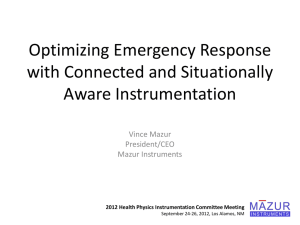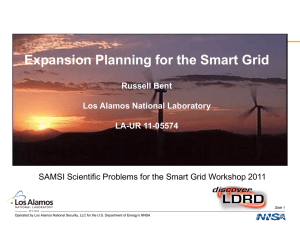PAGOSA: A Multi-Dimensional, Multi-Material, Parallel
advertisement
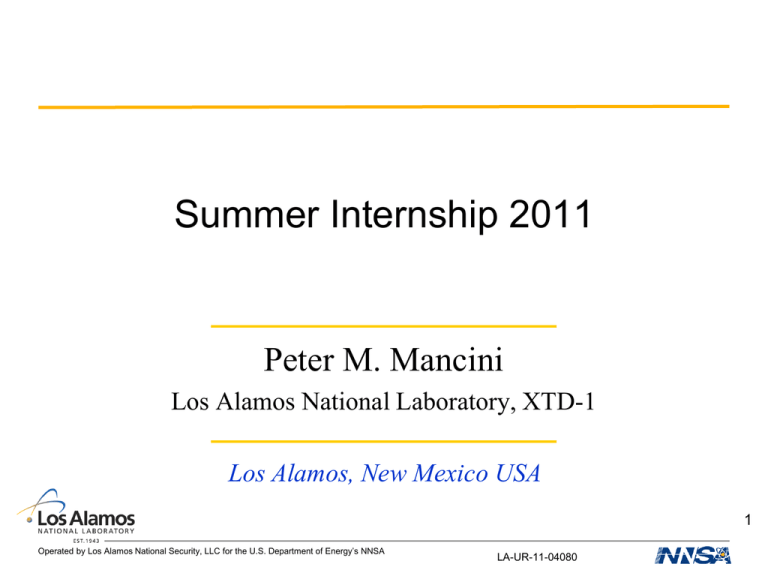
Summer Internship 2011 Peter M. Mancini Los Alamos National Laboratory, XTD-1 Los Alamos, New Mexico USA 1 Operated by Los Alamos National Security, LLC for the U.S. Department of Energy’s NNSA LA-UR-11-04080 What is LANL? • Los Alamos National Laboratory • Founded in 1943 in Los Alamos, New Mexico • Manhattan Project 2 Operated by Los Alamos National Security, LLC for the U.S. Department of Energy’s NNSA 3 Operated by Los Alamos National Security, LLC for the U.S. Department of Energy’s NNSA First Atomic Bombs Fat Man Little Boy 4 Operated by Los Alamos National Security, LLC for the U.S. Department of Energy’s NNSA What Do You Want To Do? • Research - Government/University Lab - Novel topics, laboratory work environment, no right or wrong answer • Industry - Quality control - Improve/develop current designs - Manufacturing 5 Operated by Los Alamos National Security, LLC for the U.S. Department of Energy’s NNSA Where Do You Live? • Companies in your city/state ~ 75% of the interns at LANL are from New Mexico Cheaper for the company: no travel expenses to go out there Companies here in Florida: Lockheed Martin (Orlando) Siemens (Orlando) Pratt and Whitney (West Palm Beach) o Certain hot spots for engineering i.e. Southwest U.S. has Sandia, LANL, Lawrence-Livermore National Lab 6 Operated by Los Alamos National Security, LLC for the U.S. Department of Energy’s NNSA Who Do You Know? • Networking - Find and meet people who have jobs in your desired field or at the company you would like to work for - Ask around for open positions that are often not posted on a career website • With the huge amount of “John Smiths” applying for these positions, a personal recommendation to an employer can do you wonders 7 Operated by Los Alamos National Security, LLC for the U.S. Department of Energy’s NNSA Stand Out • Words from my mentor (who is also the recruiter for X-Division): “I would take a student with a lower GPA from a decent, top 50 school with some research over a 4.0 from MIT with no real experience.” Most kids weren’t exceptionally qualified Low GPA? No worries. There are openings for you Worked with a UF sophomore You may feel like you don’t know enough to contribute to the research, but most of what you need for the job will be taught to you or you will have to read up on in textbooks and papers 8 Operated by Los Alamos National Security, LLC for the U.S. Department of Energy’s NNSA Government Labs • • • • Unique projects Tons of interesting, optional lectures Friendly work environment Plenty of students (undergraduate and graduate) to interact with • Mentors to guide you in your research 9 Operated by Los Alamos National Security, LLC for the U.S. Department of Energy’s NNSA Adventures 10 Operated by Los Alamos National Security, LLC for the U.S. Department of Energy’s NNSA Overview of Project Long Rod Penetrators (LRP) - armor-piercing ammunition generally used as anti-tank rounds Uses high kinetic energy to penetrate target KE 12 mV 2 Applies large force over small area to significantly exceed target’s yield strength g Generally use Tungsten or Uranium alloys, due to high density (~18 cm3 ) Uniqueness of problem: • Semi-infinite target to model final penetration P Lo P T • No residual velocity • Due to normal impact of penetrator, simulation can be run as a quarter of the model 11 Operated by Los Alamos National Security, LLC for the U.S. Department of Energy’s NNSA Experimental Data 1.8 1.2 1.6 1 1.4 1.2 0.8 P/L Experimental 1 Predicted 0.6 0.8 0.6 0.4 0.4 Penetration/Length (P/L) of Tungsten Rod on RHA Steel Target 0.2 0 0 0 G. Silsby, Penetration of Semi-Infinite Steel Targets By Tungsten Long Rods at 1.3 to 4.5 km/s, Eighth International Symposium on Ballistics (October 1984) 0.2 2 4 Striking Velocity (km/s) P Lo P T 12 Operated by Los Alamos National Security, LLC for the U.S. Department of Energy’s NNSA PAGOSA PAGOSA is a multi-dimensional / multi-material Eulerian hydrocode Accurately models high strain rate deformation Staggered mesh (U V W at vertices, P ρ e Sik at cell centers) Multi-material (arbitrary number of materials per cell) Young’s interface reconstruction for each material in each cell 13 Operated by Los Alamos National Security, LLC for the U.S. Department of Energy’s NNSA PAGOSA Equations of State • Void • Ideal gas analytic equation • Polynomial • Mie-Grüneisen ( Us / Up ) • Osborne analytic • Becker-Kistiakowsky-Wilson (BKW) • SESAME, tabular EOS including phase changes • Jones-Wilkins-Lee (JWL), analytic EOS for explosive materials • Reactive High Explosive (HE) Burn Models : BKW-HE, JWL-HE 14 Operated by Los Alamos National Security, LLC for the U.S. Department of Energy’s NNSA PAGOSA Strength Models • “Hydrodynamic” (no strength) • Elastic-Perfectly-Plastic • Johnson-Cook (JC) • Modified Steinberg-Cochran-Guinan (mod SCG) • Steinberg-Cochran-Guinan (SCG) • Kospall (SCG with additional thermal softening terms) • Preston-Tonks-Wallace (PTW) • Modified Preston-Tonks-Wallace (mod PTW) • Mechanical Threshold Stress (MTS) 15 Operated by Los Alamos National Security, LLC for the U.S. Department of Energy’s NNSA Example of Mesh…(1mm cell size) RHA Armor Void Vo Tungsten Penetrator 16 Operated by Los Alamos National Security, LLC for the U.S. Department of Energy’s NNSA Visual Void Target Interface Penetrator Model Space 17 Operated by Los Alamos National Security, LLC for the U.S. Department of Energy’s NNSA Mesh Convergence • Decreasing cell size increases accuracy but also increases computational run time • Computational cost increases nonlinearly with decreasing cell size due to several factors: Increased number of elements Decreased integration time steps Increased total number of integrations performed Communication between the parallel processors 18 Operated by Los Alamos National Security, LLC for the U.S. Department of Energy’s NNSA Mesh Convergence 19 Operated by Los Alamos National Security, LLC for the U.S. Department of Energy’s NNSA Equation of State Comparison • Maintained constant strength model: o Target – Elastic Perfectly Plastic o Projectile – Elastic Perfectly Plastic EOS Evaluated: o Target – Us/Up, Polynomial o Projectile – Us/Up, Polynomial Results relatively insensitive to EOS 20 Operated by Los Alamos National Security, LLC for the U.S. Department of Energy’s NNSA Flow Stress Models Elastic Perfectly Plastic: Material is linearly elastic After yield, stress remains constant with increasing load 2 constants required for PAGOSA Steinberg-Guinan and Johnson-Cook: Includes strain, pressure, and thermal softening Function of strain rate Accounts for strain hardening 7 constants required for PAGOSA 21 Operated by Los Alamos National Security, LLC for the U.S. Department of Energy’s NNSA Strength Model Comparison 22 Operated by Los Alamos National Security, LLC for the U.S. Department of Energy’s NNSA Hole Diameter Simulation of hole created at 3.335 km/s Differently sized hole diameters 23 Operated by Los Alamos National Security, LLC for the U.S. Department of Energy’s NNSA Simulation Examples Simulations • Low/High Velocity Shots • Wave Propagation 24 Operated by Los Alamos National Security, LLC for the U.S. Department of Energy’s NNSA Low velocity: 1.291 km/s *Time in microseconds (µs)* Operated by Los Alamos National Security, LLC for the U.S. Department of Energy’s NNSA 25 High Velocity: 4.525 km/s *Time in microseconds (µs)* Operated by Los Alamos National Security, LLC for the U.S. Department of Energy’s NNSA 26 Wave Propagation 27 Operated by Los Alamos National Security, LLC for the U.S. Department of Energy’s NNSA Conclusions • 1 mm cell size provides converged data in a reasonable run time. Equation of State Low Velocity Projectile: Target: Polynomial Mie-Grüneisen (UsUp) High Velocity Polynomial Mie-Grüneisen (UsUp) Strength Form Low Velocity Projectile: Target: • • • • Johnson-Cook Johnson-Cook High Velocity Steinberg-Guinan Elastic Perfectly Plastic Simulation data are generally insensitive of EOS At low velocities, results are sensitive to strength model At high velocities (> 3 km/s), the different models converge within 2% of each other and 5% of experimental data Hydrocode simulation accurately models actual physics of the penetration, i.e. residual material and stress wave propagation 28 Operated by Los Alamos National Security, LLC for the U.S. Department of Energy’s NNSA Future Work Run more data points to get a smooth curve Search for different and/or more accurate EOS, strength, and fracture models, i.e. SESAME, Osborne, Johnson-Cook Damage Compare other experimental data. Add different shaped tips to penetrator to see how it effects penetration geometry (depth, hole diameter, etc..) 29 Operated by Los Alamos National Security, LLC for the U.S. Department of Energy’s NNSA References 1. Wayne N. Weseloh, Sean P. Clancy, and James W. Painter, “PAGOSA Physics Manual,” Los Alamos National Laboratory report LA-14425-M (August 2010). 2. Wayne N. Weseloh, “PAGOSA Sample Problems,” Los Alamos National Laboratory report LA-UR-05-6514 (August 2005). 3. G. Silsby, Penetration of Semi-Infinite Steel Targets By Tungsten Long Rods at 1.3 to 4.5 km/s, Eighth International Symposium on Ballistics (October 1984) 4. Marc A. Meyers, “Dynamic Behavior of Materials,” John Wiley & Sons, Inc., 1994 5. Private communication, Shuh-Rong Chen (MST) and Wayne Weseloh (XTD-1), 8 July 2011 30 Operated by Los Alamos National Security, LLC for the U.S. Department of Energy’s NNSA Outline • Introduction / Overview • PAGOSA • Mesh Convergence • EOS Comparison • Strength Model Comparison • Simulation Examples http://www.dtc.army.mil/tts/1997/proceed/walton/walton.html i. Low/High Velocity Shots ii. Wave Propagation • Conclusions • Future Work 31 Operated by Los Alamos National Security, LLC for the U.S. Department of Energy’s NNSA Materials Experimental: Silsby (1984) Simulation: PAGOSA Projectile: Projectile: • 90W-7Ni-3Fe alloy • matname = “Tungsten” • Yield Strength - 0.0119 Mbar (174 ksi) • Yield Strength - 0.0119 Mbar (174 ksi) • Rockwell C 40.6 hardness • Shear Modulus - 1.6 Mbar g g • Density – 17.3 cm3 • Density – 17.3 cm3 • L/D = 23 - Initial Length (L) – 15.83 cm - Diameter (D) – 0.683 cm • L/D = 23 - Initial Length (L) – 15.83 cm - Diameter (D) – 0.683 cm Target: • Rolled homogeneous armor (RHA) • 6 inch plate – BHN 270.4 • 8 inch plate – BHN 231.6 Operated by Los Alamos National Security, LLC for the U.S. Department of Energy’s NNSA Target: • 6 inch plate - BNH 270.4 Yield Strength - 0.00917 (133 ksi) Shear Modulus – 0.88 (88 GPa) • 8 inch plate - BNH 231.6 Yield Strength - 0.007 (101 ksi) Shear Modulus – 0.88 (88 GPa) 32
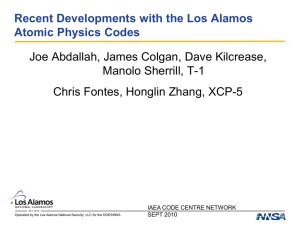
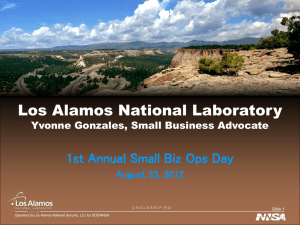
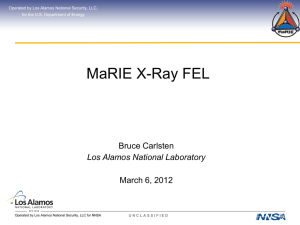
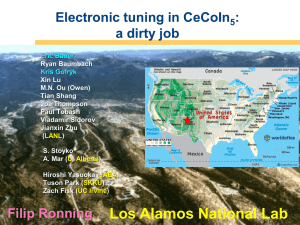
![Your_Solutions_LLC_-_New_Business3[1]](http://s2.studylib.net/store/data/005544494_1-444a738d95c4d66d28ef7ef4e25c86f0-300x300.png)

